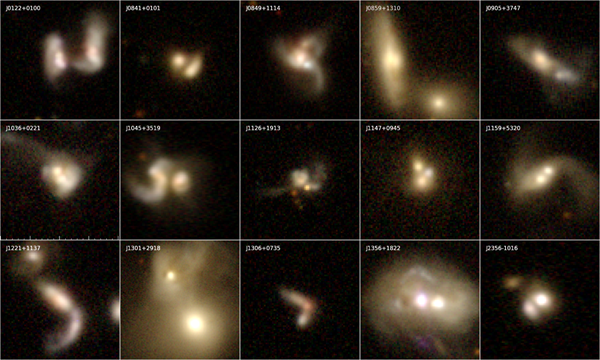Astronomers uncover hidden black holes in merging galaxies – Astronomy Magazine
These 15 images from the Sloan Digital Sky Survey show merging pairs of galaxies. A supermassive black hole lies in the brightest portion of each galaxy: its nucleus. Within this sample, astronomers have identified several pairs and two trios of actively feeding black holes.
Pfeifle et al., ApJ, Volume 875, Issue 2, i.d. 117, 2019
On June 28, Ryan Pfeifle of George Mason University presented a set of eight previously unknown dual or triple AGN at the annual meeting of the European Astronomical Society. These are merging galaxies in which the supermassive black holes in each of the participating galaxies are all actively feeding on material from their surroundings. Pfeifle’s team found these pairs and trios using data from NASA’s Wide-Field Infrared Survey Explorer (WISE) telescope and Chandra X-ray Observatory, as well as the European Space Agency’s XMM-Newton X-ray telescope. Their work was published earlier this year in the April 23 edition of The Astrophysical Journal.
Hunting AGN
AGN are most likely to be found in circumstances where there is sufficient “food” available. One such circumstance is during a galaxy merger, when two or more galaxies smash together, a process that disrupts gas, dust and stars, often sending them toward the centers of the galaxies where they can become fodder for the black hole. In some cases, two or more chomping black holes can be spotted as the merger goes through its very last stages.
But this wealth of available food has a catch. Material streaming toward the center of a galaxy feeds the black hole, but it also cloaks the black hole in dense dust and gas. This absorbs optical light from the AGN, making it invisible to optical surveys looking for signs of active black holes. But infrared light can escape as reprocessed light — energy from the AGN that has been absorbed by the dust around it and then re-emitted by those dust grains at longer (infrared) wavelengths.
This is why using WISE was the key to finding these AGN. By searching in infrared light, the team uncovered AGN that would have been missed by other surveys. Pfeifle’s team selected objects that looked like AGN in the infrared data, then followed up by observing them in X-ray light, too. X-rays can shoot straight through gas and dust, and are a clear sign of a feeding black hole. By matching the two samples, the team could even determine whether the X-rays seemed to be coming from one or more sources: single, dual, or triple AGN.






